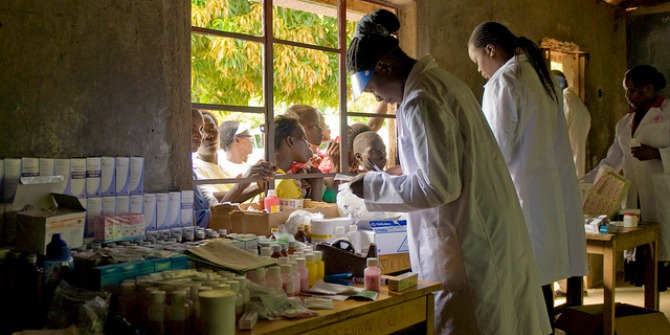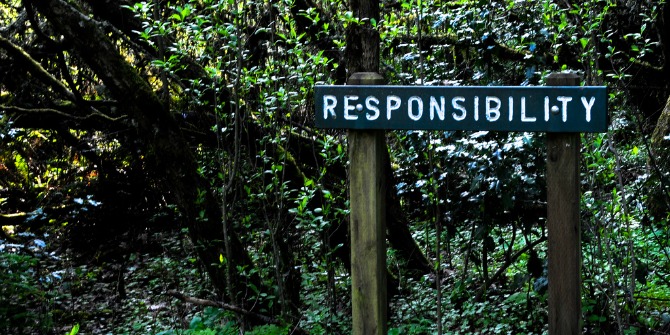 Collaboration holds great promise for social science disciplines, but simply replicating practices from STEM disciplines will not necessarily lead to greater quality research. Each discipline has its own language and set of assumptions, argues Jenny Lewis and ground work must be done to set the stage for a successful exchange of ideas. Disciplines that rest on strongly contested knowledge bases need to work harder to collaborate. Much more needs to be done to understand what type of collaborative structures help social science academics produce not just more research but high quality research.
Collaboration holds great promise for social science disciplines, but simply replicating practices from STEM disciplines will not necessarily lead to greater quality research. Each discipline has its own language and set of assumptions, argues Jenny Lewis and ground work must be done to set the stage for a successful exchange of ideas. Disciplines that rest on strongly contested knowledge bases need to work harder to collaborate. Much more needs to be done to understand what type of collaborative structures help social science academics produce not just more research but high quality research.
There are a series of beliefs, half-truths, and stretched assumptions about collaboration as the salvation of the social sciences. These include that collaboration:
- increases publication quantity
- improves the chances of securing competitive research funding
- produces research that has a greater impact
- leads to the production of more innovative research
- generates higher quality research
- has benefits when working on large and complex (interdisciplinary) projects
- is more effective (increases research quantity, quality and impact) if it is international.
These assumptions are often leaps of faith for the social sciences. Collaboration is not easily defined, nor is it easy to measure its benefits. Collaboration is not the same in all disciplines and it is not cost-free or even low cost, particularly once you start crossing many disciplinary and geographic boundaries. It does not always work well, and it does not always lead to better quality research – or even a greater quantity of research. I will return to this later, but first a few words about disciplines.
There is often an implicit assumption in the social sciences that we should follow how ‘big science’ does collaboration. But we don’t need large equipment, mostly. We might benefit from having teams, but they are not large in general. We are not always problem-driven, although we sometimes are. We have less specialisation in the sense that there is more overlap between what we read across the disciplinary boundaries. And we are not paradigmatic. When we write we rehearse previous arguments to demonstrate a depth of knowledge of the dispersed and contested existing field, before adding our own contribution. This is a major part of the reason why we write 80,000 word books rather than 2,000 word articles.
 Image credit: OpenSource.com (Flickr, CC BY-SA)
Image credit: OpenSource.com (Flickr, CC BY-SA)
A Humanities, Arts and Social Sciences (HASS) academic who begins to work with people from five other disciplines is standing on disputed ground, so it is harder to begin engaging across disciplines. It can be extremely time consuming to get to the starting line of a large-scale interdisciplinary collaboration since each discipline has its own language and set of assumptions. Before a sociologist begins to collaborate (successfully) with people from information systems, engineering, or even psychology, this ground work must be done.
So collaboration, particularly interdisciplinary collaboration, is not cost-free or even low cost. Disciplines that rest on strongly contested knowledge bases need to work harder to collaborate – even with others from the same discipline. This is not to say that collaboration in HASS is not rewarding. But it is also difficult to find the necessary time when there is a need to be producing the required level of outputs. The safer option, particularly for early career academics, is to stick with more traditional ways of working.
But what does research collaboration actually mean? A distinction into three ideal types, some variation of which is used in referring to all sorts of collaborative arrangements, helps. The first type can be labelled collaboration and is distinguished by a structured and goal-oriented arrangement. A second type, ‘cooperation’ is, by contrast, informal and opportunity-driven. In between these two is a middle ground, sometimes referred to as coordination. This is more balanced between structured and informal, and goal-oriented and serendipitous modes of working. In the Science, Technology, Engineering and Mathematics (STEM) disciplines, collaboration tends to signify project teams which are more formal and goal-oriented. Collaboration for the HASS disciplines tends to be more informal and serendipitous. These types are shown in Figure 1. A similar typology is the division of organizational types into formal and informal, with semi-formal in between. Some argue that it is the last of these that help knowledge-intensive organizations to be more innovative and more productive.
Figure 1: Collaboration, coordination and cooperation
Should HASS academics leapfrog over the middle ground between loose network cooperation into structured team collaborations? There may be some very good instrumental reasons for doing this (grant seeking for example), but is this the right model for collaboration in the non-STEM disciplines? The mid-range structure of coordination, or semi-formal organizations, seems a better target to aim for. It is not clear that all of HASS belongs in a highly structured space.
Another distinction can be made between highly instrumental and visible collaboration and more expressive and hidden versions, which can be stated as two questions:
- Who do you publish with? (co-authorship); and
- Who do you discuss your ideas with? (intellectual exchange)
Co-authorship is one concrete measure of collaboration, as is holding joint grants. Yet assuming that joint grants and co-authorship on publications are the only signifiers of collaboration provides a very one-dimensional view. The more expressive side of collaboration points to the exchange of ideas that is fundamental to good academic work, even if there is no visible sign of this in co-authorship.
Disciplinary differences in publication practices are well known. A humanities scholar might produce a single book in a particular year, either with no co-authors or with one. A social scientist will generally have more publications within a year and will have a mixture of journal articles and book contributions. For someone in the biological and physical sciences, a large number of publications, each with multiple authors, will be considered standard. Figure 2 shows examples of co-authorship in one year, for each of an historian, a behavioural scientist and a radiologist.
Figure 2: Co-authorship patterns for different disciplines
HASS academics who spend time exchanging ideas, and then contributing individually authored chapters to an edited book, do not appear to collaborate in sociograms like this. This might not be the strongest form of academic collaboration, but the exchange of ideas has likely had an influence on the contributions. Such interactions can also lead to future, probably more formal, collaborations.
On the more informal and expressive side of collaboration, when you ask academics who they discuss their ideas with, the patterns for disciplines are quite different. [see Lewis (2013) Academic governance: Disciplines and policy. New York: Routledge] In the sciences there is more of a hierarchy. Often discussion partners will be in the same geographic location, but they are not likely to be the same gender. Perhaps more interestingly, academics within these groups will not necessarily consider the people that they discuss their ideas with as friends – they are simply colleagues. The picture that emerges is that for the scientists, research is problem and project-oriented, and this is not just seen in their co-authorship practices but also in whom they exchange ideas with.
In the humanities and social sciences, discussion partners are more likely to be at the same level of seniority, and to be the same gender. However, the academics that they exchange ideas with are less likely to be in the same location. For HASS academics, personal closeness is higher amongst their discussion partners than it is for scientists: The people they discuss their ideas with are more often considered as not just colleagues, but also friends.
This analysis of differences begs the question; can HASS move closer to STEM in its collaborative practices? It seems likely that the differences in intellectual exchange between these disciplines are associated with their different approaches to, and indeed amounts of, concrete collaboration. Is it possible for HASS academics to work more with their departmental colleagues, and people that they do not feel personally close to? The numbers of people with similar interests in the same location in HASS departments is small, and scholarship is more often linked to personal values that obviate against working with others.
Collaboration holds great promise for the HASS disciplines. It can be immensely rewarding for individuals and in advancing knowledge if the appropriate structures are achieved. The literature does demonstrate that collaboration leads to more publications (depending on how you fraction out the co-authorship). Interdisciplinary collaboration and international collaboration have been shown to lead to more citations.
The difficulty for HASS disciplines is that, practically without exception, all of this literature is based on analyses of the STEM disciplines. Its relevance to HASS disciplines, with their different patterns of intellectual exchange and concrete collaboration patterns is unclear. And none of the (proven) arguments for collaboration are actually about the quality of research produced – although a solid argument can be made about the benefits of bringing more and diverse knowledge to bear on a particular problem, and the benefits of international cooperation.
There are certainly some things to learn from STEM in regard to collaboration, but simply replicating this will not necessarily help the HASS disciplines. The most effective route seems likely to be a mid-range collaboration strategy that is not too highly structured. Alongside this strategy there is a need to recognise that collaboration in the HASS disciplines looks different, is harder to observe, and takes more incubation time and space. Finally, much more needs to be done to understand what type of collaborative structures work for HASS academics, and help them to produce not just more research but high quality research.
Note: This article gives the views of the author, and not the position of the Impact of Social Science blog, nor of the London School of Economics. Please review our Comments Policy if you have any concerns on posting a comment below.
Jenny M Lewis is Professor of Public Policy and an Australian Research Council Future Fellow for 2013-2016 in the School of Social and Political Sciences at The University of Melbourne, Australia. She has published widely on public policy processes and governance change, and has ongoing projects on research collaboration and measuring research performance.










1 Comments